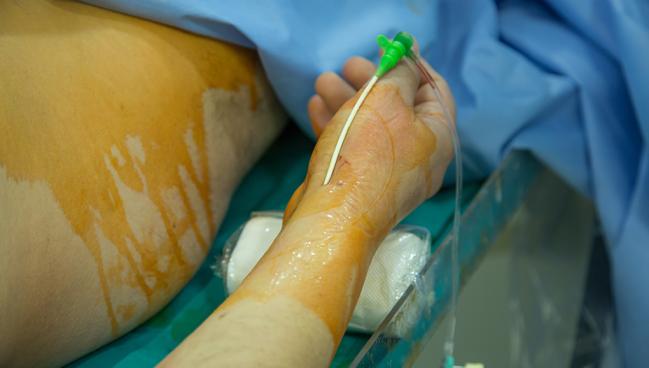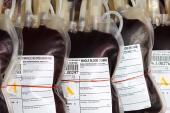Radial Access Is Safe, Effective for Peripheral Interventions: R2P Registry
The radial-to-peripheral approach is a viable alternative to femoral access for many procedures, Andrew Klein says.

It is feasible to forgo femoral access and go through the radial artery for many complex lower-extremity interventions, findings from the prospective R2P registry suggest.
Across a range of PAD lesions, the radial-to-peripheral (R2P) approach carried a high procedural success rate (93.3%), with only one case involving a conversion to femoral access, according to researchers led by Yulanka Castro-Dominguez, MD (University Hospitals Cleveland Medical Center, OH).
There were no serious adverse events adjudicated to be related to the procedure, with a 16.7% rate of nonserious complications related to the radial access site. The mean time to ambulation was 3-and-a-half hours, with most patients (86.7%) being discharged the same day.
The study, published Monday in JSCAI, shows that for peripheral interventions, radial access “is another tool in our armamentarium,” senior author Mehdi Shishehbor, DO, PhD (University Hospitals Cleveland Medical Center), told TCTMD. Getting patients sent home faster will increase satisfaction, he added, and help with healthcare system issues like bed availability, staffing, and cost.
“The study is encouraging, and I hope that people selectively start doing this, gain the experience, and find out for themselves who are the people they think they can do via the radial approach and who are the people they can’t,” Shishehbor said. “I wouldn’t say that this is for 100% of the patients, or even 70% of the patients, but I think you have to start somewhere. If you’re doing 20% to 30% radial, I think that’s a good start right now given that we still have some limitations with some of the equipment.”
Indeed, not all of the tools commonly used by peripheral operators are long enough to reach from the radial artery down into the legs, although some companies are working on that, noted Andrew Klein, MD (Piedmont Heart Institute, Atlanta, GA), chair of the vascular disease council of the Society for Cardiovascular Angiography and Interventions (SCAI).
But even so, “radial access is here to stay,” he commented to TCTMD. “I think it is a safe, viable alternative to femoral access that affords operators the ability to complete many peripheral procedures in a relatively low-risk fashion with easy access, easy ability to obtain hemostasis, and successful outcomes.”
Bringing Prospective Data to the Table
Though there has been a lot of movement away from femoral access to radial access in recent years in the coronary space, bolstered by a number of clinical trials and subsequent guideline recommendations, there remains a paucity of data regarding the use of radial access for peripheral interventions, Shishehbor said. That’s despite the fact that patients with PAD are more likely than those with coronary disease to develop complications related to a femoral puncture.
That discrepancy could be related, Shishehbor said, to some concerns about the radial-to-peripheral approach, including the greater distance that needs to be covered to reach the lower extremities, the tolerability of having a large sheath in a patient’s arm for 2 to 3 hours during complicated vascular procedures, and the potential for more damage to the arteries and a greater risk of stroke when going through the radial versus femoral artery.
There have been some studies of the R2P approach, but they have mostly been retrospective and conducted in small groups of patients at single centers.
The R2P registry, which involved eight US centers, was designed to provide much-needed prospective data to evaluate the use of radial access during a broad range of peripheral interventions. The current analysis included 120 patients (mean age 68.7 years; 31.7% women) who had symptomatic PAD (Rutherford class 2 to 5 symptoms) and were scheduled for an intervention using radial access.
Overall, operators treated 224 lesions, with 12.9% in the iliac segment, 55.3% in the femoropopliteal segment, 11.9% isolated popliteal lesions, and 19.5% in the tibial vessels. One-third were chronic total occlusions.
After ultrasound-guided radial access was obtained, operators employed a variety of devices from a single manufacturer (Terumo)—including sheaths, angioplasty balloons, stents, and hemostasis compression devices—specially designed for radial use. The mean procedure time was 74 minutes, with a median time to discharge of just under 4 hours.
Although only one procedure required a conversion to femoral access—due to excessive iliac tortuosity and calcification—25% required secondary retrograde access sites (ie, pedal, tibial, or popliteal) to facilitate crossing, to complete the planned treatment, or both.
We need longer-length devices to be able to do some of these complex procedures. Mehdi Shishehbor
Most patients (95%) received plain balloon angioplasty, 7.5% drug-coated balloon angioplasty, and 38.3% a self-expandable BMS. Atherectomy was deployed in more than half of patients—50.8% orbital and 2.5% laser.
The primary efficacy endpoint was procedural success, defined as completion of the intended procedure without a conversion to femoral access or periprocedural radial artery complications, and this was met by all but eight patients. Other than the single conversion to femoral access, there were seven complications, including one pseudoaneurysm, four radial artery spasms, and two minor access-site bleeds.
Through 30 days, there were no serious adverse events, and 20 nonserious radial access-site complications addressed with manual compression, longer radial closure band application, or no additional interventions.
Of note, 97.2% had ultrasound-confirmed patency of the radial artery at 30 days.
When to Go Radial, and When to Avoid It
Klein said the strengths of the study include the involvement of multiple centers and operators, the prospective design, the “pretty decent” number of patients, and the 31.7% proportion of women, who are generally smaller than men and may have smaller radial arteries. Thus, it’s good to see that the R2P approach was feasible in female patients, he said.
Also noteworthy was the inclusion of more-distal lesions in the isolated popliteal and tibial segments, because it shows that these areas can be reached from the radial artery, as well as the use of atherectomy in about half of cases, showing that it’s feasible to perform complex procedures through the wrist, Klein said.
But the study also highlighted some potential limitations of the radial approach, he said, pointing to the 25% rate of additional access to facilitate treatment and the relatively low rate of drug-coated balloon (DCB) use. The latter finding underscores the need for device manufacturers to introduce longer shaft lengths to allow for DCB use via radial access, he indicated.
Overall, the study demonstrates that the R2P approach is viable, at least in some patients, Klein said. “For our patients that are shorter, this is a good option for them,” he said. “Obviously it can’t be done on everybody, can’t be done on patients with certain anatomy, but I do think it’s a valid option and I think this study shows this.”
One situation in which operators may want to avoid radial access is if they are concerned about the possibility of needing to use a covered stent for bailout, Klein said. “I would avoid super-complex areas at high risk for perforation at this time, especially because you may run out of length, and the last thing you want to do is be in an emergency situation and not have enough access to be able to treat the patient.”
Moving forward, he said, there is clearly a need for studies comparing clinical outcomes and cost-effectiveness between radial and femoral access.
Shishehbor pointed out that there is a learning curve associated with performing peripheral interventions through the wrist, but he indicated that that wouldn’t be a huge obstacle for most operators.
“As we continue to show the evidence, as we continue to show that the patients want this kind of procedure because it’s more comfortable for them, they get to go home the same day, there’s less cost, and they can be done safely, I think I’m not too worried that people can pick this up and be able to do it,” he said, agreeing with Klein that there is a need for some innovation to make more devices available for radial access. “We need longer-length devices to be able to do some of these complex procedures.”
Ultimately, shifting more to radial access and avoiding femoral complications will not only improve patient satisfaction but also increase quality overall, Shishehbor said. “Being able to do these procedures without getting into trouble with the groin will have a significant quality impact for these patients that have vascular disease.”
Todd Neale is the Associate News Editor for TCTMD and a Senior Medical Journalist. He got his start in journalism at …
Read Full BioSources
Castro-Dominguez Y, Li J, Lodha A, et al. Prospective and multicenter registry to assess safety and efficacy of radial access for peripheral artery interventions: R2P registry. JSCAI. 2023;Epub ahead of print.
Disclosures
- The study was funded by Terumo Medical.
- Castro-Dominguez reports consulting for Boston Scientific and Medtronic.
- Shishehbor reports being a consultant and advisor to Abbott Vascular, Boston Scientific, Medtronic, Philips, and Terumo.
- Klein reports no relevant conflicts of interest.





Comments